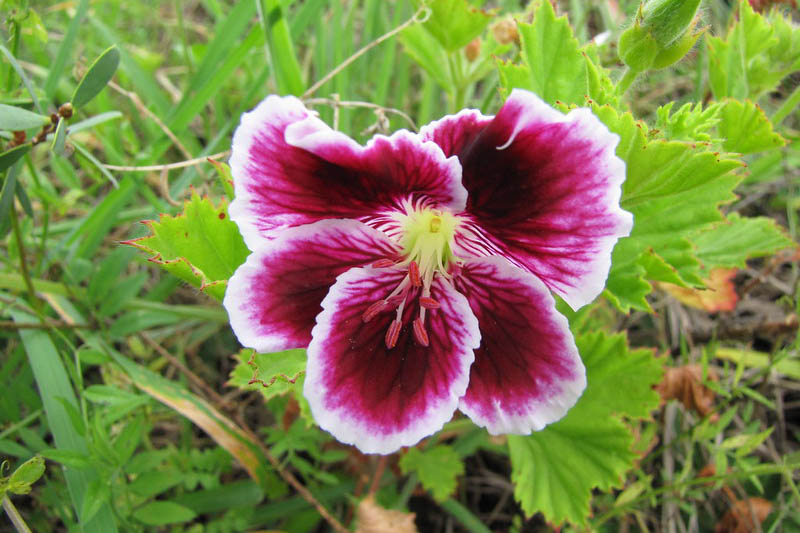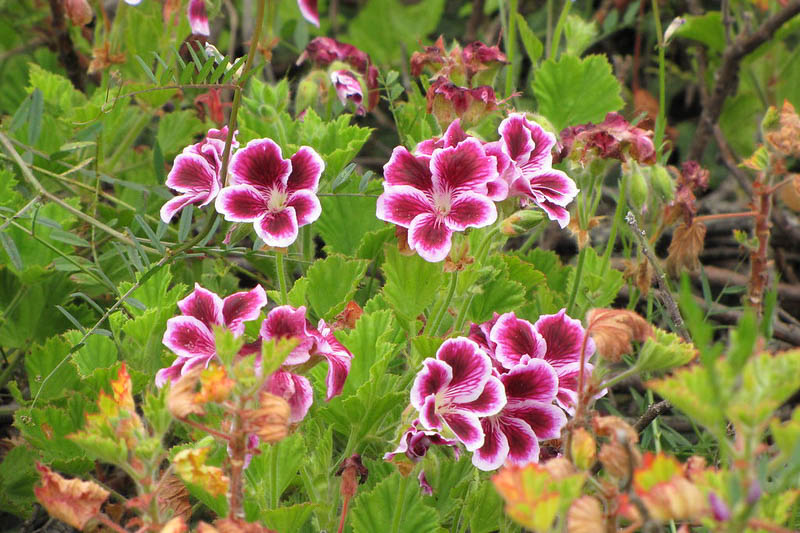Regal Geranium, Martha Washington Geranium
Pelargonium x domesticum, commonly known as Regal Geranium or Martha Washington Geranium, is a stunning and robust plant renowned for its showy flowers and decorative leaves.
Regal Geranium is distinguished by its large, vibrantly colored flowers and broad, green leaves. The flowers are uniquely patterned, often showcasing a mix of colors, including shades of purple, red, pink, and white, often with contrasting veining or blotches.
Native: Regal Geraniums are a grouping of hybrid geraniums involving P. grandiflorum and P. cucullatum. They are of garden origin, developed through hybridization rather than native to a specific region. Regal Geraniums belong to the Geraniaceae family, which includes both the genus Geranium (the cranesbills, or true geraniums) and the genus Pelargonium (garden plants called geraniums), along with other related genera.
Plant Type and Habit: The Regal Geranium is a tender evergreen perennial often grown as an annual in temperate climates. It has an upright, bushy habit, making it ideal for container gardening and formal bedding arrangements.
Size: Typically, the Regal Geranium reaches a height of 12 to 36 inches (30-90 cm) with a spread of 12-24 inches (30-60 cm). Its compact form allows it to fit well in garden borders and pots.
Flowers: Regal Geraniums showcase large, showy flowers with ruffled petals in a vibrant array of colors including pink, red, white, and purple, often marked with contrasting veins or blotches, making them stand out in any garden setting. They bloom profusely from late spring through fall.
Foliage: Regal Geranium boasts rounded, heart-shaped to kidney-shaped, deeply serrated mid-green leaves, enhancing their ornamental appeal and providing a lush backdrop to their vibrant floral display.
Hardiness: Pelargonium x domesticum is hardy in USDA zones 10-11. In most temperate regions, it is treated as an annual or overwintered indoors to protect it from frost. It requires consistently cool nighttime temperatures for successful flower formation and tends to struggle with blooming in climates characterized by hot, humid summers.
Uses: It is predominantly used as an ornamental plant in containers, hanging baskets, and as bedding in gardens. Its showy nature makes it a favorite for public and private displays that seek to impress with vivid colors.
Toxicity: Pelargoniums are toxic to cats, dogs, and horses.
Invasiveness: Regal Geranium is not considered invasive. It does not aggressively spread and is typically contained within its planting area, whether in a garden bed or a container.
Benefits: Apart from its ornamental value, growing Regal Geranium can be quite rewarding due to its relatively easy care and long-lasting, colorful blooms.

Growing and caring for Regal Geraniums (Martha Washington Geraniums) involves specific practices to ensure they thrive both indoors and outdoors. Here are tailored guidelines for each environment:
Lighting: Place them in a location that receives bright, indirect light for at least 4-6 hours a day.
Soil: Regal Geranium prefers well-drained fertile neutral to alkaline soil.
Temperature: Keep the indoor temperature between 60°F and 70°F (15°C-21°C). These plants prefer cooler conditions and should be kept away from heaters and air conditioners that can create sudden temperature fluctuations.
Watering: Water when the top inch of the soil feels dry. In indoor settings, it’s crucial to ensure that the soil is moist but not soggy. Use pots with good drainage.
Humidity: Regal geraniums appreciate moderate humidity. In drier indoor climates, occasional misting or a humidity tray can help.
Fertilizing: Use a balanced liquid fertilizer every two weeks during the growing season, but dilute it to half the strength recommended on the label. Reduce feeding in the winter months.
Pruning: Regularly deadhead spent blooms and prune back leggy growth to encourage a compact, bushy form. This helps the plant conserve energy and promotes more blooms.
Location: Outdoors, choose a spot with full sun but some light shade in the heat of the day, especially in hotter climates.
Soil: Plant in well-draining, neutral to alkaline soil. If your garden soil is heavy or clay-like, consider amending it with compost or planting in raised beds with a suitable potting mix.
Watering: Water deeply but infrequently, allowing the soil to dry out between watering. This is especially important outdoors where evaporation rates may vary.
Fertilizing: Similar to indoor care, fertilize every two weeks during the growing season with a diluted water-soluble fertilizer. Cease fertilization in late fall as the plant prepares for dormancy.
Pruning: Consistently remove faded flowers and yellow leaves to maintain plant health and appearance.
Winter Care: In regions where temperatures fall below freezing, regal geraniums should be treated as annuals or brought indoors before the first frost. They can be overwintered in a cool, bright place.

Propagating Regal Geraniums can be a rewarding way to expand your garden. The most common method for propagating these plants is through stem cuttings. Here’s a step-by-step guide on how to propagate Regal Geraniums using this method:
Select the Right Time: Late spring or early summer is ideal for taking cuttings, as the plant is in its active growth phase.
Choose Healthy Stems: Look for healthy, non-flowering stems to cut. These should be free of disease, pests, and damage.
Cut the Stem: With clean, sharp scissors or shears, cut a 4-6 inch piece of stem just below a leaf node (the point where leaves grow out of the stem). Each cutting should have at least three sets of leaves.
Prepare the Cutting: Remove the leaves from the lower half of the cutting to prevent moisture loss and potential rotting when planted. If you have rooting hormone, dip the cut end of the stem into it to encourage root growth.
Plant the Cutting: Fill a small pot with a well-draining potting mix. Make a hole in the center of the soil with a pencil or your finger, and plant the stem cutting into the soil, ensuring that the leaf nodes where you removed the lower leaves are buried.
Water Gently: Water the soil lightly but thoroughly to settle the cutting in place. The soil should be moist but not waterlogged.
Create Humidity: To maintain humidity, which helps the cuttings root, cover the pot with a plastic bag or place it under a clear plastic cover. Make sure the plastic does not touch the leaves. Keep the pot in indirect light; direct sunlight can overheat the plant under plastic.
Monitor and Care: Check the soil periodically to ensure it remains moist, and watch for signs of growth. Rooting typically occurs in 4-8 weeks. Once new growth appears, gradually acclimate the plant to less humidity by removing the plastic cover for longer periods each day.
Transplanting: Once the cuttings have established a robust root system, you can transplant them into larger pots or directly into the garden, depending on your climate and the time of year.
Regal Geraniums are prized for their vibrant flowers but can be susceptible to a variety of pests, diseases, and common problems.
Whiteflies: These tiny white insects cluster on the undersides of leaves, causing yellowing and weakening of the plant as they suck the sap. Use yellow sticky traps to monitor and reduce their numbers, and apply insecticidal soap or horticultural oils.
Spider mites: Indicated by fine webbing on the plant and discolored leaves, spider mites thrive in dry conditions. Increase humidity around your plants and use miticides if necessary.
Aphids: These small, soft-bodied insects cluster on the undersides of leaves and stems, sucking sap and causing leaves to curl and distort. Aphid infestations can also lead to sooty mold because of the honeydew they excrete. Wash aphids off with a strong jet of water or use insecticidal soap or neem oil.
Root rot: Overwatering and poor drainage can lead to root rot, where the roots start decaying. Ensure good drainage in pots and don’t overwater. Infected plants may need to be repotted with fresh, sterile potting mix and damaged roots trimmed away.
Rust: Rust appears as small, orange or brownish spots on the underside of leaves. Remove infected leaves and avoid overhead watering. Fungicide treatments can help in severe cases.
Leaf Yellowing: Overwatering, poor drainage, or nutrient deficiencies (especially nitrogen) can cause yellowing leaves. Check watering practices and ensure the plant is not sitting in water. Consider using a balanced fertilizer.
Flower Bud Drop: Sudden changes in temperature, improper watering (too much or too little), or high humidity can cause regal geraniums to drop their buds. Maintain a stable environment, particularly avoiding high heat or drafts.
Leggy Growth: Insufficient light often causes plants to become “leggy,” with long, weak stems and sparse leaves. Move plants to a brighter location or use grow lights if indoor lighting is insufficient.
| Hardiness |
10 - 11 |
|---|---|
| Climate Zones | 8, 9, 12, 13, 14, 15, 16, 17, 18, 19, 20, 21, 22, 23, 24 |
| Plant Type | Houseplants, Perennials |
| Plant Family | Geraniaceae |
| Genus | Pelargonium |
| Exposure | Full Sun, Partial Sun |
| Season of Interest |
Spring (Late) Summer (Early, Mid, Late) Fall |
| Height |
1' - 3' (30cm - 90cm) |
| Spread |
1' - 2' (30cm - 60cm) |
| Spacing |
12" - 24" (30cm - 60cm) |
| Maintenance | Low |
| Water Needs | Average |
| Soil Type | Loam, Sand, Chalk, Clay |
| Soil pH | Alkaline, Neutral |
| Soil Drainage | Well-Drained |
| Characteristics | Showy, Evergreen |
| Garden Uses | Beds And Borders, Patio And Containers |
| Garden Styles | City and Courtyard, Informal and Cottage |
| Hardiness |
10 - 11 |
|---|---|
| Climate Zones | 8, 9, 12, 13, 14, 15, 16, 17, 18, 19, 20, 21, 22, 23, 24 |
| Plant Type | Houseplants, Perennials |
| Plant Family | Geraniaceae |
| Genus | Pelargonium |
| Exposure | Full Sun, Partial Sun |
| Season of Interest |
Spring (Late) Summer (Early, Mid, Late) Fall |
| Height |
1' - 3' (30cm - 90cm) |
| Spread |
1' - 2' (30cm - 60cm) |
| Spacing |
12" - 24" (30cm - 60cm) |
| Maintenance | Low |
| Water Needs | Average |
| Soil Type | Loam, Sand, Chalk, Clay |
| Soil pH | Alkaline, Neutral |
| Soil Drainage | Well-Drained |
| Characteristics | Showy, Evergreen |
| Garden Uses | Beds And Borders, Patio And Containers |
| Garden Styles | City and Courtyard, Informal and Cottage |
How many Pelargonium x domesticum (Regal Geranium) do I need for my garden?
| Plant | Quantity | |
|---|---|---|
| Pelargonium x domesticum (Regal Geranium) | N/A | Buy Plants |
Create a membership account to save your garden designs and to view them on any device.
Becoming a contributing member of Gardenia is easy and can be done in just a few minutes. If you provide us with your name, email address and the payment of a modest $25 annual membership fee, you will become a full member, enabling you to design and save up to 25 of your garden design ideas.
Join now and start creating your dream garden!
Create a membership account to save your garden designs and to view them on any device.
Becoming a contributing member of Gardenia is easy and can be done in just a few minutes. If you provide us with your name, email address and the payment of a modest $25 annual membership fee, you will become a full member, enabling you to design and save up to 25 of your garden design ideas.
Join now and start creating your dream garden!